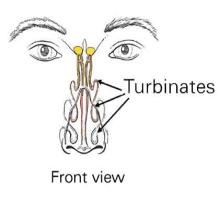How The Respiratory System Works

Fig 14: normal healthy humidified, filtered and heated, inspiration through nose.
Inspiration: When the diaphragm contracts, the lungs expand: Following Boyle’s law: the expansion of the lungs means that the overall air-pressure in them – drops. As air like any other fluid or gas – aspires to equalize the pressure with its surroundings – air will always travel from high-pressure areas to low-pressure areas. Infact – the low pressure areas – suck air into them, and thus – when the diaphragm contracts and the lungs expand – air is drawn through the nose into the pharynx and down through the trachea – into the lungs, where the O2 and CO2 exchange in the alveoli at the end of the lungs’ bronchioles. The job of supplying the lungs with warm, moist and filtered clean air, while maintaining laminar airflow patterns – steady in stream and forward pressure – is entirely up to the nose. One can breath through the mouth only or an opening in the trachea, but it is highly uncomfortable, hazardous in the long term for the lungs’ health, and very unsatisfying. That’s why – only nasal breathing is satisfying, healthy and relaxing.
Here is what the AAO (The American Academy of Otolaryngology – Head and Neck Surgery) has to say about the importance of the nose in the breathing process:
Your Nose: The Guardian Of Your Lungs
You might not think your nose is a “vital organ,” but indeed it is! To understand its importance, all that most people need to experience is a bad cold. Nasal congestion and a runny nose have a noticeable effect on quality of life, energy level, ability to breathe, ability to sleep, and ability to function in general.
Why Is Your Nose So Important?
It processes the air that you breath before it enters your lungs. Most of this activity takes place in and on the turbinates, located on the sides of the nasal passages. In an adult, 18,000 to 20,000 liters of air pass through the nose each day.
 Your Nose Protects Your Health By:
Your Nose Protects Your Health By:
- Filtering all that air and retaining particles as small as a pollen grain with 100% efficiency.
- Humidifying the air that you breath, adding moisture to the air to prevent dryness of the lining of the lungs and bronchial tubes.
- Warming cold air to body temperature before it arrives in your lungs.
For these and many other reasons, normal nasal function is essential. Do your lungs a favor; take care of your nose.
Because the connection between the nose and lungs is so important, paying attention to problems in the nose–allergic rhinitis for instance–can reduce or avoid problems in the lungs such as bronchitis and asthma. Ignoring nasal symptoms such as congestion, sneezing, runny nose, or thick nasal discharge can aggravate lung problems and lead to other problems:
- Nasal congestion reduces the sense of smell.
- Mouth breathing causes dry mouth, which increases the risk of mouth and throat infections and reduces the sense of taste. Mouth breathing also pulls all pollution and germs directly into the lungs; dry cold air in the lungs makes the secretions thick, slows the cleaning cilia, and slows down the passage of oxygen into the blood stream.
- Ignoring nasal allergies increases the chance that you will develop asthma; it also makes asthma worse if you already have it.
So, it is important to treat nasal symptoms promptly to prevent worsening of lung problems. Tips To Improve The Health Of Your Nose And Lungs:
- If your nose is dry, its various functions will be impaired. Try over-the-counter salt-water (saline) nasal mists and sprays to help maintain nasal health. These can be used liberally and at your discretion.
- Beware of over-the-counter nasal decongestant sprays; prolonged use of these sprays may damage the cilia that clear the nose and sinuses. Decongestants can become addictive and actually cause nasal congestion to get worse.
- Think of your nose when you’re traveling. Air-conditioned cruise ships may have high levels of mold in the cabins. Airplane air is very dry and contains a lot of recirculated particles and germs; a dry nose is more susceptible to germs. Use saline nasal mist frequently during the flight, and drink lots of water.